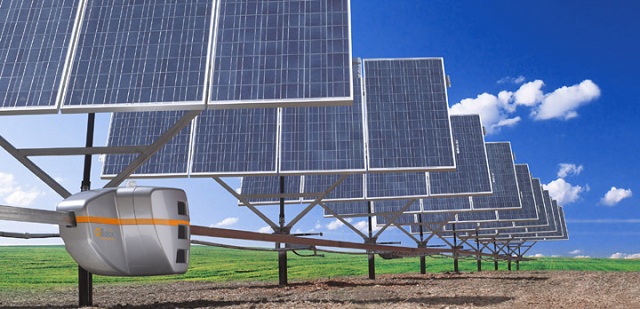Solar energy key in bridging digital divide

Gibson Mhaka
THE nightmare for jobseekers with a rural background these days is dealing with companies that demand one to be computer literate as a pre-requisite for employment. But how does someone like Dickson Mudimba in remote Binga and Nyasha Chikwizha in Dotito become computer literate when they have never used a computer let alone switched on lights either at school or at home?
On the other hand, seven-year-old Langton Sibanda at an up-market school in Bulawayo has access to a computer at the school and at home. The boy has a tablet and a desktop in his own bedroom in the leafy suburb of Burnside.
Although government has made strides in electrifying rural areas which were left undeveloped by the colonial regime, there are still many rural places that do not have electricity. This has caused the huge digital gap between rural and urban people as mirrored by the situation of Mudimba and Langton.
Lack of electricity in some rural areas has severely disadvantaged a whole generation of children as they lag behind the rest of the world in terms of Information and Communication Technologies (ICTs).
As a result of this growing disparity, urban youths are more likely to find employment when competing with their rural counterparts. President Robert Mugabe has over the years provided computers to schools, including rural ones.
The President’s dream is to see every pupil have access to computers which is part of his national ICT revolution. However, his efforts in computerising rural schools have been hamstrung by lack of electricity in some parts.
Experts in the energy sector say investments in solar energy are overdue, given the slow pace of the rural electrification programme. They say the market for solar energy development is vast in the country because of the abundant sunlight as Zimbabwe boasts of the highest solar radiation in the world.
Solar-powered computer laboratories will expose school children in rural areas to computers while helping to address the country’s power deficit. Agriculture and rural development expert, Charles Dewa, who is also chief executive officer for Knowledge Council Africa, says investment in solar power is one of the most lucrative business opportunities in the country.
He says the constant supply of sunlight throughout the country makes solar power ideal in tackling the country’s power shortfalls. Zimbabwe has about 3,700 hours of solar radiation.
“Although it will be an expensive project for the government but as energy experts we have a couple of reasons why we believe solar energy is an alternative that is easy to provide electricity to millions of people in rural areas.
“Of all the other alternative and renewable sources of energy available for the country, solar power is the most abundant and free. Solar energy is clearly the fastest way to get all the country’s rural schools electrified.
“Most schools in urban areas are fortunate enough to have a steady supply of electricity. Unfortunately rural schools are not as lucky, and this has a severe adverse impact on children’s education. I think that solar powered computer labs are a great way to expand rural children’s technological knowledge. This will in the long run help the country develop,” said Dewa.
Madziwa Secondary School in Chipinge scored a first in the country in bridging the digital gap between rural dwellers and their urban counterparts when an international firm Computer Aid International, in conjunction with Unesco set up a solar-powered computer lab at the school.
Commissioning the solar-powered computer lab, Unesco coordinator, Innocent Chademana, urged the government to embrace renewable sources of energy as a development tool. Chademana says there is a need to install similar solar labs throughout the country so that marginalised communities also embrace ICTs.
“The government has donated computers to various schools around the country but what boggles the mind is that these computers are lying idle because of lack of electricity. We are urging the corporate world to come on board and fund the establishment of this solar-powered system that is cost effective,” he said.
Solar energy specialist Leeroy Baloyi, a director of TASS Electrical Company which builds solar plants at schools and health centres, said they were engaging the government over the solar project. He said TASS wants to build solar power plants for schools and health centres which are distant from the national power grid.
“We are engaging the government so that we can invest in solar power in schools and health centres located too far off of the national grid. We will be working with responsible officials in the education and health sectors to install solar panels at schools and health centres.
“TASS has since identified some schools in the rural areas that can’t afford their own solar-power systems so that we build and lease out solar-powered computer labs at low cost. The schools can get the power they need at a lower cost,” said Baloyi. He says the model has been successfully applied in Rwanda where the government invested in solar power for more than 300 rural schools and 46 health centres.
“It’s the smart thing to do in the wake of climate change. We want other private players to support, encourage and enable this investment,” says Baloyi. Investment in solar energy also benefits the agricultural sector where farmers can make use of solar-powered irrigation pumps.
A case in point is of two major irrigation schemes in Gwanda district which had become dysfunctional due to water shortages as a result of constant breakdown of the diesel engine pumps. The irrigation schemes received a life line after they were connected to a solar plant which is now running more than 16 electric pumps at the two projects.
Briefing delegates and journalists during a field tour of the solar farm and irrigation schemes, Practical Action’s Engineer Shepherd Masuka said the solar farm was capable of generating 99 kilowatts, which is enough to run the irrigation schemes.
“The solar panels have a life span of 25 years running at 100 percent and that is enough power to run the irrigation schemes. After that period they will still be enough power for the schemes as it will be running at 80 percent. So farmers are guaranteed uninterrupted power in their operations,” he said.
Gwanda Rural District Council engineer, Samukeliso Masiyane, said the programme was in line with the government’s economic blueprint, Zim-Asset. The economic Zim-Asset recognises that to achieve the desired social and economic prosperity, the country must boost access to cheaper and reliable energy while minimising environmental hazards and ensuring sustainability.
But even with the compelling advantages solar power offers, there are challenges that come with it. These include securing of finance and also lead times involved to implement the projects in order to meet growing electricity demands.
Energy and Development ministry permanent secretary Partson Mbiriri once said although solar energy is an inexhaustible source of energy, reliability and the cost of producing makes it “impracticable” to heavily invest in it as a panacea to the challenges facing the country with regards to electricity generation.
“It’s expensive to generate it as a source of energy compared to other renewable sources such as hydro and thermal power. For example, if you are producing hydro energy at a cost of four cents per kilowatt hour per square metre, when it comes to solar energy it will be between 17-25 cents per kilowatt hour per square metre. Remember that the more you want to produce at that cost will cause the tariffs to go up thereby putting a burden on consumers which will automatically take us to the political arena,” observed Mbiriri.
There is no doubt that Zimbabwe has vast potential for solar power from photovoltaic cells and can attract investors for its energy sector. The Zimbabwe Energy Regulatory Authority (ZERA) which was commissioned by government to develop a feed-in tariff policy and boosting private sector participation in the development of renewable energy sources has so far licensed five solar power projects, valued at a total of $250 million.
It is vital that both the government and private sector invest in power energy opportunities to help bridge the digital divide between rural and urban areas.










Comments